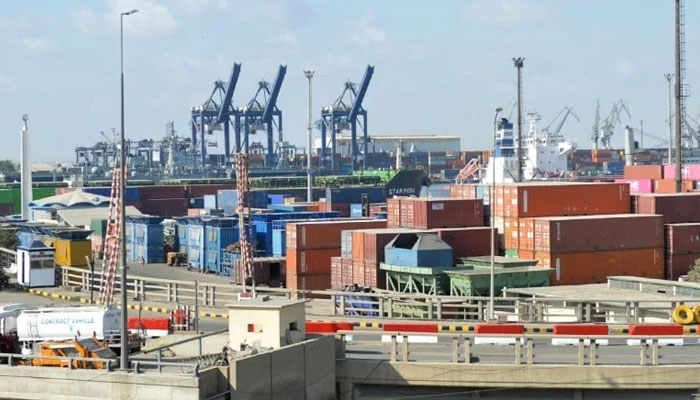Export potential
LAHORE: A combination of sound policies, an improved regulatory framework, and an enabling business environment, along with a beyond-textiles approach, if sustained, will help unlock the private sector's potential to double Pakistan's exports in the next two years.
In an unusual move, the government has announced an export advisory committee that comprises members from different exporting sectors, including agriculture. Sectors outside the textiles were exporting their products without any facilitation from the government. These sectors do not demand subsidies but simply desire the removal of small impediments and bureaucratic red tape.
The exports of sheet glass leaped rapidly when non-subsidized facilitations were provided to glass manufacturers in recent months. Pakistan's agriculture exports jumped by 30 percent during the first four months of this fiscal year while imports declined appreciably.
Cement's exports increased by 40 percent during this period. Jewelry exports increased by 30 percent during the first four months of this fiscal year.
The textile exports during July-Oct 2023 registered a negative growth of -6.3 percent, though there was an increase in October. The actions taken to facilitate the IT sector are likely to net Pakistan $10 billion in exports in the next two years.
This year, the IT exports would hover around $3 billion. Most experts say that despite gloom in global markets, Pakistan can achieve the target by unleashing the non-textile potential of the country.
Top among these sectors is agriculture. Pakistan Hitech Hybrid Seed Association (PHHSA) chairman Shahzad Ali Malik (SI) believes that agricultural growth in all crops has gone down in the last three decades.
However, we saw remarkable growth in the yields of coarse rice and maize in recent years. He said both crops were developed by private sector entrepreneurs by providing quality hybrid seeds and guiding the farmers throughout the cultivation cycle.
Poverty has gone down appreciably in the regions where coarse rice and maize are cultivated because the farmers obtained three to four times higher yields than conventional low-yield seeds that they used earlier. The next logical step was to produce those seeds in Pakistan. In this regard, hybrid rice seed of a coarse variety is being produced in the country that caters to 50 percent of the country's needs.
The producer is enhancing capacity, besides other entrepreneurs who have also signed joint ventures to produce hybrid rice seed. The maize importers would soon be establishing their plants to produce hybrid rice.
China is slowly opting out of agriculture. Our hybrid rice technology was provided by China. Recently, a Chinese company has agreed to provide hybrid chili seed to Guard Agriculture.
Guard Agriculture will distribute the seeds to the farmers and export the produce to China in the first phase. It would also get technology from the Chinese company to produce hybrid chili seed in Pakistan.
At the same time, the Chinese have signed an agreement with the Karachi-based Techno group to process chili produced from Chinese seeds and export the total chili powder that it produces.
Though the government has set a target of achieving $100 billion in exports in the next two years, it does not look realistic. In fact, we would be lucky if we even cross the $35 billion barrier by the end of this year.
-
 Queen Camilla Tugs At Heartstrings By Talking About Cancer And Not Needing To ‘pretend’
Queen Camilla Tugs At Heartstrings By Talking About Cancer And Not Needing To ‘pretend’ -
 North West Skips Traditional School As Kim Kardashian Explains Why
North West Skips Traditional School As Kim Kardashian Explains Why -
 Prince Harry Claims Media Has ‘no Limits’ In Light Of Diana Death
Prince Harry Claims Media Has ‘no Limits’ In Light Of Diana Death -
 Andrew Inches To The Point Of No Return As He Loses What Little He Had Remaining As The King’s Brother
Andrew Inches To The Point Of No Return As He Loses What Little He Had Remaining As The King’s Brother -
 Inside Meghan Markle’s Recipe Drop After Netflix Decides Against ‘With Love, Meghan’ Season 3
Inside Meghan Markle’s Recipe Drop After Netflix Decides Against ‘With Love, Meghan’ Season 3 -
 Brooklyn Beckham’s Pre-nup Details, Secrets And Divorce Settlement Comes To Light
Brooklyn Beckham’s Pre-nup Details, Secrets And Divorce Settlement Comes To Light -
 Royal Camp Is Focused On Fighting Against ‘Harry Distractions:’ Expert
Royal Camp Is Focused On Fighting Against ‘Harry Distractions:’ Expert -
 Andrew’s Gun License Turns Into The Final Straw? ‘To Him There’s Nothing Left Worth Getting Out Of Bed For’
Andrew’s Gun License Turns Into The Final Straw? ‘To Him There’s Nothing Left Worth Getting Out Of Bed For’ -
 Kim Kardashian Shares One Regret She Wishes Had Not Happened
Kim Kardashian Shares One Regret She Wishes Had Not Happened -
 Why Blake Lively Claims 'It Ends With Us' 'nearly Killed' Her?
Why Blake Lively Claims 'It Ends With Us' 'nearly Killed' Her? -
 Brooklyn Beckham’s Statement Gets Run Over: ‘You Wouldn’t Have Any Of This Yourself’
Brooklyn Beckham’s Statement Gets Run Over: ‘You Wouldn’t Have Any Of This Yourself’ -
 Princess Beatrice Follows Eugenie Into Anguish As Their ‘York Greek Tragedy’ Threatens Family Further
Princess Beatrice Follows Eugenie Into Anguish As Their ‘York Greek Tragedy’ Threatens Family Further -
 Prince Harry Urges His Pals Are ‘not Leaky,’ He Is Not ‘Mr Mischief’
Prince Harry Urges His Pals Are ‘not Leaky,’ He Is Not ‘Mr Mischief’ -
 What Prince William And Kate Think Of Brooklyn's Attack On Victoria And David Beckham?
What Prince William And Kate Think Of Brooklyn's Attack On Victoria And David Beckham? -
 Meghan Trainor Reveals Why Surrogacy Was The 'safest' Choice
Meghan Trainor Reveals Why Surrogacy Was The 'safest' Choice -
 Victoria Beckham Supports Youngest Son In First Move Since Brooklyn's Rebellion
Victoria Beckham Supports Youngest Son In First Move Since Brooklyn's Rebellion




